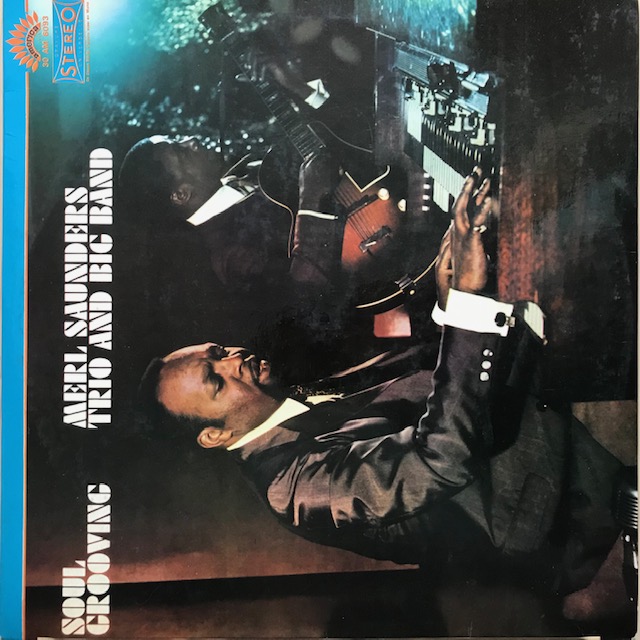Organist Merl Saunders’ debut album from 1968, Soul Grooving, definitely is hot. Seems like the fellow from Frisco swallowed a chunk of chili pepper.
Personnel
Merl Saunders (organ), Jimmy Daniels (bass), Eddie Moore (drums), unidentified orchestra, Ray Shanklin’ (arranger)
Recorded
in 1968
Released
as Galaxy in 1968
Track listing
Side A:
Soul Roach
Lonesome Fever
I Pity The Fool
Up, Up And Away
Ode To Billy Joe
Side B:
My Train
Angel Eyes
Is You Is Or Is You Ain’t My Baby
Tighten Up
Soul Groovin’
The liner notes of the raucous Soul Grooving tell that Merl Saunders was based in his birthplace of San Francisco, where he started out on piano and attended the University of California. During his stint in the army in Germany in the mid-fifties, Saunders studied music at the University of Mainz and appeared in the Ed Sullivan Show. He took up the organ in 1959 and accompanied, among others, Dinah Washington.
His trio consists of bassist Jimmy Daniels and drummer Eddie Moore. Daniels boasts experience of playing with Johnny “Hammond” Smith, Moore with Jimmy Smith and Wes Montgomery. Nice resumé. Saunders piqued the interest of the Flophouse Detective Agency a couple of years ago and it found out that the organist cooperated with Jerry “Grateful Dead” Garcia in the late 60s and early 70s. It makes sense. Perhaps a Pinkerton sleuth spotted Saunders and Garcia on the day when they first met in Haight-Ashbury, amidst the daydreamin’ flower children, secretly planning all sorts of musical experimentation. You can trust it your Pinkerton man knows his dandelion masquerades.
Nothing of the Frisco vibe, however, rubbed off on Soul Grooving, not even a whiff of incense. No LSD but straight shots of Cutty Sark. And pork chops with lots of gravy. Soul Groovin’ is 24 carat chitlin’ circuit music, groove tailor-made and born out of the circuit of clubs that tended to the black audience. It is part of the universe of ‘race’ music, which was the name for black music until Alan Freed dubbed it ‘rhythm & blues’: same thing, gospel rhythm-based music with profane lyrics, except that with Freed’s package festivals, the white audience came into the equation and soon we’d have rock & roll, Chuck Berry, Bobby Womack, Bo Diddley etcetera, who inspired pale white and blue collar cats from Britain like Jagger and Richards and the Davies brothers, and then there was rock. Rock would not have existed without race music.
And Soul Grooving has its modest place in the pantheon, which runs from Cab Calloway, Louis Jordan, Jimmy Smith, B.B. King to Jimi Hendrix, who paid his dues in the circuit playing with Little Richard and Curtis Knight, among others. Soul Grooving was released in the late sixties, the tail end of the circuit’s existence. As a result of the disintegration of the black neighborhoods, which was hastened by the incoming, havoc-reaping flood of hard drugs, and the rise of disco music, the circuit more of less perished, and with it the communal aspect that lay at the heart of the music’s vitality and strength. Rap and Hip Hop would eventually revitalize the community, in an extremely different way and not in a circuit of clubs but on the basketball court and in the barren streets of New York.
At the time of Soul Grooving, Merl Saunders enjoyed a residency at club Jack’s of Sutter in San Francisco. The album consists of trio performances and tunes that are enhanced with big band scores by arranger Ray Shanklin. The combination of big ensembles and Hammond organ had been tried before, quite successfully, by Jimmy Smith, Jimmy McGriff, Groove Holmes and Shirley Scott. Merl Saunders is a superb addition to the niche. Big brass collides with the crunchy organ on the blues-soul shuffle Tighten Up, a Saunders/Shanklin original that reaches for the sexy, sweaty vibe of the Ike & Tina Turner Soul Revue, steadily working towards orgasm.
Soul Grooving is littered with such wild rides, including the title track, a boogaloo burner lighted by a rebellious, honking tenor sax solo. My Train, also by Saunders & Shanklin, is a copy of This Train, which, as we know from various sources including Big Bill Broonzy, carries no gamblers. With admirable originality, Saunders does not take a level-headed approach to ballads, including them as mere breathers or filler, but, picking different sounds out of the keyboard, lends an eerie film noir quality to Angel Eyes and Lonesome Fever, the latter another Saunders tune that is enlivened by excellent double-timing of the guitarist.
The band is of all-round quality and raises a number of relatively simple tunes to another level. The funky drumming of Up, Up And Away is wild and would’ve made Idris Muhammad smile broadly. For that matter, though I don’t know about the Pinkerton fellows, it has the Flophouse Sleuths grinning from ear to ear.

